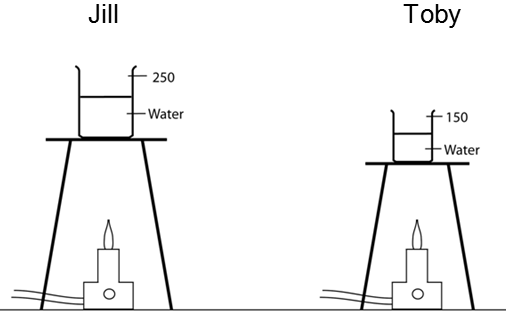Boiling water

| Y10 (08/2009) | |||||||||||||||
| a) |
i) |
Toby’s In Toby’s experiment
(or the opposite of the above if they discuss Jill’s experiment) |
very easy All 3 identified - very difficult |
||||||||||||
| b) |
|
|
All identified - very difficult |
||||||||||||
| Common response | Likely misconception | |
| a) ii) |
Most students gave only one variable. Some students identified the amount of water and the size of the beakers. |
Most students answered that Toby had less water than Jill. However, a few of the students also explained that less water would take less time to boil. Many students ignored the second important variable, the distance of the water from the flame. Although the size of the beakers is a variable in this experiment it has little impact in comparison to the variables of distance to the flame and amount of water to heat. See Next steps. |
| b) |
Most students again gave just one variable. Very few students mentioned the variable of time. Some students said the amount of gas being let through the Bunsen burner. |
The most common variable given was the same amount of water. When it was included it was not explained. For example most students who included time just said “same time” rather than heat for the same amount of time or begin experiments at the same time. These students are not clear about what they understand about the mixture of the gas and that it is the amount of oxygen in the fuel which affects the heat of the flame. This amount of oxygen is the independent variable, and it does need to be different so that a comparison can be made in the data. |
Students easily identified one variable which did affect the experiment. However few listed multiple variables. Students need to look at each investigation as one whole system and consider all the variables that could impact on this system. They could practise this by considering the variables in other simple familiar investigations. For example, if using the “burning peanut”, you could direct students to consider the range of relevant variables and explain why each one needs to be considered. For example:
- the size of the peanut - do larger peanuts have more oil?
- the age of the peanut - do older peanuts have less oil?
- the amount of heat used to initiate the burning – will quickly catching the peanut alight waste less oil?
- the experimental techniques, e.g., height of the boiling tube above the flame, timing issues, measuring issues, etc.
Understanding the impact of a variable
Once students have thought about the range of variables they could then decide how much of an impact each variable would make. For example in the boiling water experiment some students identified that the beakers were of different sizes. However this variable may have little effect on the outcome because although a larger surface area on the base of a large beaker allows water in the beaker to heat up more quickly than the water in a smaller beaker (heat from the flame is in contact with more water) in this experiment, it is the amount of water that mainly affects the outcome. The larger beaker holds about twice as much water as the smaller beaker so the relative advantage of greater surface area for its base is more than cancelled out. Students could plan and carry out experiments to investigate this, in doing so gaining more practise at managing the other variables.
- There are many ARB resources that focus on fair testing and control of variables.
- Use the key words “fair testing” and “variables” plus the context you are focussing on to find other resources.
-
Science investigations gives a brief summary of different sorts of investigations.
- Warm feet
- Baking soda and lemon juice
- Dissolving sugar and salt
- Making bubbles II
- Making bubbles
- Carbonate reactions
- Testing swimsuit fabric
- Wanganui and Wellington water
- Static electricity investigation
- Solar showers
- Freezing salt water
- Find the best solvent
- Insulated house
- Green plants and light
- Investigating crater impact
- Soaking up water
- Which liquid flows best?
- Keeping drinks warm
- Which paper soaks up most water?
- Insulating a house
- Which type of sugar dissolves best?
- The best insulator
- Viscosity of liquids
- Effect of surface area on evaporation rate
- How well does a "green" fridge work?
- Electric kettles
- Which parachute floats the longest?
- Burning peanuts
- Spheres and cubes
- Nail investigation
- Cooking potatoes
- Bouncing soccer balls
- Dissolving milo
- Microwave Ovens
- Growing radishes
- Rolling marbles III
- Rolling marbles
- Rolling marbles II
- Falling play dough
- Rusting nails
- The best mopper upper
- Evaporating water
- Bendy ruler
- Sliding cubes
- Sliding, spinning, tumbling

